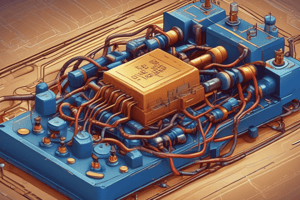Podcast
Questions and Answers
What is the unit of measurement for permittivity (ε)?
What is the unit of measurement for permittivity (ε)?
Farads per meter (F/m)
What is the relative permittivity (εr) of a dielectric material?
What is the relative permittivity (εr) of a dielectric material?
The ratio of the permittivity of the material to that of a vacuum (εr = ε / ε₀)
What are the two types of polarization that occur in a dielectric material when an electric field is applied?
What are the two types of polarization that occur in a dielectric material when an electric field is applied?
Electronic polarization and orientational polarization
What is the electric field strength (E) proportional to in a capacitor?
What is the electric field strength (E) proportional to in a capacitor?
How does the permittivity of a dielectric material affect the electric field strength?
How does the permittivity of a dielectric material affect the electric field strength?
What is the purpose of permittivity in a dielectric material?
What is the purpose of permittivity in a dielectric material?
What is the effect of polarization on the electric field strength within a dielectric material?
What is the effect of polarization on the electric field strength within a dielectric material?
What is the unit of measurement for electric field strength (E)?
What is the unit of measurement for electric field strength (E)?
Flashcards are hidden until you start studying
Study Notes
Dielectrics Constant in Capacitor
Permittivity
- Permittivity (ε) is a measure of a dielectric material's ability to store electric energy.
- It is a scalar quantity, typically denoted by the symbol ε (epsilon).
- Permittivity is measured in Farads per meter (F/m).
- The permittivity of a dielectric material is always greater than that of a vacuum (ε₀ = 8.85 × 10⁻¹² F/m).
- The relative permittivity (εr) is the ratio of the permittivity of the material to that of a vacuum.
εr = ε / ε₀
Polarization
- Polarization occurs when an electric field is applied to a dielectric material.
- The electric field causes the molecules of the material to align themselves with the field, resulting in an induced dipole moment.
- There are two types of polarization:
- Electronic polarization: The displacement of electrons within the molecule.
- Orientational polarization: The alignment of permanent dipoles within the material.
- Polarization reduces the electric field strength within the material, increasing the capacitance of the capacitor.
Electric Field Strength
- Electric field strength (E) is the force per unit charge at a given point in space.
- It is measured in Volts per meter (V/m).
- In a capacitor, the electric field strength is proportional to the voltage (V) and inversely proportional to the distance between the plates (d).
E = V / d
- The electric field strength is also affected by the dielectric material, with a higher permittivity resulting in a weaker electric field.
- The electric field strength is an important factor in determining the capacitance and breakdown voltage of a capacitor.
Dielectrics Constant in Capacitor
Permittivity
- Permittivity (ε) measures a dielectric material's ability to store electric energy.
- It is a scalar quantity denoted by the symbol ε (epsilon).
- Permittivity is measured in Farads per meter (F/m).
- The permittivity of a dielectric material is always greater than that of a vacuum (ε₀ = 8.85 × 10⁻¹² F/m).
- Relative permittivity (εr) is the ratio of the permittivity of the material to that of a vacuum: εr = ε / ε₀.
Polarization
- Polarization occurs when an electric field is applied to a dielectric material.
- The electric field causes molecule alignment, resulting in an induced dipole moment.
- There are two types of polarization: electronic polarization (electron displacement) and orientational polarization (permanent dipole alignment).
- Polarization reduces the electric field strength within the material, increasing capacitance.
Electric Field Strength
- Electric field strength (E) is the force per unit charge at a given point in space, measured in Volts per meter (V/m).
- In a capacitor, E is proportional to voltage (V) and inversely proportional to the distance between plates (d): E = V / d.
- Electric field strength is also affected by the dielectric material, with higher permittivity resulting in a weaker electric field.
- Electric field strength determines capacitance and breakdown voltage of a capacitor.
Studying That Suits You
Use AI to generate personalized quizzes and flashcards to suit your learning preferences.




